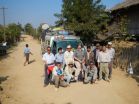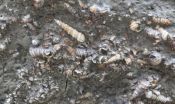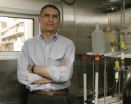(Press-News.org) The Asian monsoon already existed 40 million years ago during a period of high atmospheric carbon dioxide and warmer temperatures, reports an international research team led by a University of Arizona geoscientist.
Scientists thought the climate pattern known as the Asian monsoon began 22-25 million years ago as a result of the uplift of the Tibetan Plateau and the Himalaya Mountains.
"It is surprising," said lead author Alexis Licht, now a research associate in the UA department of geosciences. "People thought the monsoon started much later."
The monsoon, the largest climate system in the world, governs the climate in much of mainland Asia, bringing torrential summer rains and dry winters.
Co-author Jay Quade, a UA professor of geosciences, said, "This research compellingly shows that a strong Asian monsoon system was in place at least by 35-40 million years ago."
The research by Licht and his colleagues shows the earlier start of the monsoon occurred at a time when atmospheric CO2 was three to four times greater than it is now. The monsoon then weakened 34 million years ago when atmospheric CO2 then decreased by 50 percent and an ice age occurred.
Licht said the study is the first to show the rise of the monsoon is as much a result of global climate as it is a result of topography. The team's paper is scheduled for early online publication in the journal Nature on Sept. 14.
"This finding has major consequences for the ongoing global warming," he said. "It suggests increasing the atmospheric CO2 will increase the monsoonal precipitation significantly."
Unraveling the monsoon's origins required contributions from three different teams of scientists that were independently studying the environment of 40 million years ago.
All three investigations showed the monsoon climate pattern occurred 15 million years earlier than previously thought. Combining different lines of evidence from different places strengthened the group's confidence in the finding, Licht said. The climate modeling team also linked the development of the monsoon to the increased CO2 of the time.
Licht and his colleagues at Poitiers and Nancy universities in France examined snail and mammal fossils in Myanmar. The group led by G. Dupont-Nivet and colleagues at Utrecht University in the Netherlands studied lake deposits in Xining Basin in central China. J.-B. Ladant and Y. Donnadieu of the Laboratory of Sciences of the Climate and Environment (LSCE) in Gif-sur-Yvette, France, created climate simulations of the Asian climate 40 million years ago.
A complete list of authors of the group's publication, "Asian monsoons in a late Eocene greenhouse world," is at the bottom of this release, as is a list of funding sources.
Licht didn't set out to study the origin of the monsoon.
He chose his study site in Myanmar because the area was rich in mammal fossils, including some of the earliest ancestors of modern monkeys and apes. The research, part of his doctoral work at the University of Poitiers, focused on understanding the environments those early primates inhabited. Scientists thought those primates had a habitat like the current evergreen tropical rain forests of Borneo, which do not have pronounced differences between wet and dry seasons.
To learn about the past environment, Licht analyzed 40-million-year-old freshwater snail shells and teeth of mammals to see what types of oxygen they contained. The ratio of two different forms of oxygen, oxygen-18 and oxygen-16, shows whether the animal lived in a relatively wet climate or an arid one.
"One of the goals of the study was to document the pre-monsoonal conditions, but what we found were monsoonal conditions," he said.
To his surprise, the oxygen ratios told an unexpected story: The region had a seasonal pattern very much like the current monsoon – dry winters and very rainy summers.
"The early primates of Myanmar lived under intense seasonal stress – aridity and then monsoons," he said. "That was completely unexpected."
The team of researchers working in China found another line of evidence pointing to the existence of the monsoon about 40 million years ago. The monsoon climate pattern generates winter winds that blow dust from central Asia and deposits it in thick piles in China. The researchers found deposits of such dust dating back 41 million years ago, indicating the monsoon had occurred that long ago.
The third team's climate simulations indicated strong Asian monsoons 40 million years ago. The simulations showed the level of atmospheric CO2 was connected to the strength of the monsoon, which was stronger 40 million years ago when CO2 levels were higher and weakened 34 million years ago when CO2 levels dropped.
Licht's next step is to investigate how geologically short-term increases of atmospheric CO2 known as hyperthermals affected the monsoon's behavior 40 million years ago.
"The response of the monsoon to those hyperthermals could provide interesting analogs to the ongoing global warming," he said.
INFORMATION:
Researcher contact information:
Alexis Licht
University of Arizona
alicht@email.arizona.edu
Languages spoken: French and English
Jay Quade
University of Arizona
quadej@email.arizona.edu
(520) 626-1847
Jean-Jacques Jaeger
University of Poitiers (France)
+33549453758
jean-jacques.jaeger@univ-poitiers.fr
Guillaume Dupont-Nivet
University of Rennes (France)
+493319775784 (currently in Potsdam, Germany)
guillaume.dupont-nivet@univ-rennes1.fr
Yannick Donnadieu
+33169088666
Laboratory of Sciences of the Climate and Environment (France)
Yannick.Donnadieu@lsce.ipsl.fr
Related Web sites:
Alexis Licht:
http://www.ipgp.fr/~licht/index.html
Jay Quade:
http://www.geo.arizona.edu/Quade
UA Geosciences:
http://www.geo.arizona.edu/
Complete list of authors and their affiliations:
A. Licht (University of Arizona, Tucson; University of Poitiers, France; and Centre of Petrographic and Geochemical Research (CRPG), Vandoeuvre les Nancy, France); M. van Cappelle (Utrecht University, Netherlands and Imperial College, London); H. A. Abels (Utrecht University, Netherlands and University of Leuven, Belgium); J.-B. Ladant (Laboratory of Sciences of the Climate and Environment (LSCE), Gif-sur-Yvette, France); J. Trabucho-Alexandre (Durham University, U.K); C. France-Lanord (CRPG, Vandoeuvre les Nancy, France); Y. Donnadieu (LSCE, Gif-sur-Yvette, France); J. Vandenberghe (Vrije University, Amsterdam): T. Rigaudier (CRPG, Vandoeuvre les Nancy, France); C. Lécuyer (University of Lyon, France); D. Terry Jr. (Temple University, Philadelphia); R. Adriaens (University of Leuven, Belgium); A. Boura (Pierre and Marie Curie University and National Museum of Natural History, Paris); Z. Guo (Peking University, Beijing); Aung Naing Soe (Defence Services Academy, Pyin Oo Lwin, Myanmar); J. Quade (University of Arizona, Tucson); G. Dupont-Nivet (University of Leuven, Belgium; Peking University, Beijing; University of Rennes, France; University of Potsdam, Germany); J.-J. Jaeger (University of Poitiers, France).
The research was supported by the following organizations: 09-BLAN-0238-02 Program of the French National Research Agency (ANR); the Universities of Poitiers and Nancy; the Netherlands Organisation for Scientific Research (NWO-ALW); the Marie Curie Career Integration Grant (CIG) 294282; the Ministry of Culture of the Republic of the Union of Myanmar; the French Ministries of Foreign Affairs and of Higher Education and Research; the Alexander von Humboldt Foundation; the Chinese Ministry of Education; the National Natural Science Foundation of China; and the Fyssen Foundation.
Asian monsoon much older than previously thought
2014-09-15
ELSE PRESS RELEASES FROM THIS DATE:
University of Leeds press release: One care lapse can be fatal for heart attack patients
2014-09-15
University of Leeds research has revealed that heart attack patients have a 46% increased chance of death within a month of discharge if they miss any one of nine types of care.
There is also a 74% increased chance of dying within one year if any one component of care is missed.
The nine pathways of care that have been identified are pre-hospital electrocardiogram, acute use of aspirin, restoring blood flow to the heart (known as reperfusion), prescription at hospital discharge of aspirin, timely use of four types of drug for heart attack (ACE-inhibitors, beta-blockers, ...
New insights in survival strategies of bacteria
2014-09-15
Bacteria are particularly ingenious when it comes to survival strategies. They often create a biofilm to protect themselves from a hostile environment, for example during treatment with antibiotics. A biofilm is a bacterial community that is surrounded by a protective slime capsule consisting of sugar chains and "curli". Scientists at VIB and Vrije Universiteit Brussel have for the first time created a detailed three-dimensional image of the pores through which the curli building blocks cross the bacterial cell wall, a crucial step in the formation of the protective slime ...
How an ancient vertebrate uses familiar tools to build a strange-looking head
2014-09-15
Kansas City, Mo. - If you never understood what "ontogeny recapitulates phylogeny" meant in high school, don't worry: biologists no longer think that an animal's "ontogeny", that is, its embryonic development, replays its entire evolutionary history. Instead, the new way to figure out how animals evolved is to compare regulatory networks that control gene expression patterns, particularly embryonic ones, across species. An elegant study published in the September 14, 2014 advance online issue of Nature from the Stowers Institute for Medical Research shows just how humbling ...
Breast screening for over 70s doesn't prompt sharp fall in advanced disease
2014-09-15
Instead, it may just lead to overdiagnosis and overtreatment, suggest the researchers, led by a team based at Leiden University Medical Centre in the Netherlands.
Their paper publishes as the Preventing Overdiagnosis conference opens next week (Monday 15 Sept), where experts from around the world will discuss how to tackle the threat to health and the waste of money caused by unnecessary care. The conference is hosted by the Centre for Evidence-Based Medicine at the University of Oxford in partnership with The BMJ's Too Much Medicine campaign.
The upper age limit for ...
Experts raise concern over unnecessary treatment of mild hypertension in low risk people
2014-09-15
Dr Stephen Martin and colleagues argue that this strategy is failing patients and wasting healthcare resources. They call for a re-examination of the threshold and urge clinicians to be cautious about treating low risk patients with blood pressure lowering drugs.
Their paper publishes as the Preventing Overdiagnosis conference opens next week (Monday 15 Sept), where experts from around the world will discuss how to tackle the threat to health and the waste of money caused by unnecessary care. The conference is hosted by the Centre for Evidence-Based Medicine at the University ...
Genetic testing can identify men at 6-fold increased risk of prostate cancer
2014-09-15
Scientists can now explain a third of the inherited risk of prostate cancer, after a major international study identified 23 new genetic variants associated with increased risk of the disease.
The study brings the total number of common genetic variants linked to prostate cancer to 100, and testing for them can identify 1% of men with a risk of the disease almost six times as high as the population average.
Scientists at The Institute of Cancer Research, London, and in Cambridge, UK, and California led a huge search for new genetic variants including almost 90,000 men ...
Rules of thumb for climate change turned upside down
2014-09-15
Based on models and observations, climate scientists have devised a simplified formula to describe one of the consequences of climate change: regions already marked by droughts will continue to dry out in the future climate. Regions that already have a moist climate will experience additional rainfall. In short: dry gets drier; wet gets wetter (DDWW).
However, this formula is less universally valid than previously assumed. This was demonstrated by a team of ETH climate researchers led by Peter Greve, lead author of a study recently published in Nature Geoscience. Traditional ...
Measuring modified protein structures
2014-09-15
Cells regulate protein functions in a wide variety of ways, including by modifying the protein structure. In an instant, a protein can take on another form and perform no or even the "wrong" function: in humans, proteins that fold wrongly can cause serious diseases such as Alzheimer's, Parkinson's or cystic fibrosis. Some of these proteins also have a tendency to "infect" other molecules of the same type and congregate into insoluble so-called amyloid fibrils or plaques. These amyloids can damage cells and tissues and make people ill.
Method breaks the shackles
Until ...
UNC researchers find final pieces to the circadian clock puzzle
2014-09-15
CHAPEL HILL, NC – Researchers at the UNC School of Medicine have discovered how two genes – Period and Cryptochrome – keep the circadian clocks in all human cells in time and in proper rhythm with the 24-hour day, as well as the seasons. The finding, published today in the journal Genes and Development, has implications for the development of drugs for various diseases such as cancers and diabetes, as well as conditions such as metabolic syndrome, insomnia, seasonal affective disorder, obesity, and even jetlag.
"Discovering how these circadian clock genes interact has ...
Cheaper alternative to licensed drug for treating eye disease has similar side-effects
2014-09-15
Health policies which favour using ranibizumab for treating eye disease in older people over safety concerns for a cheaper alternative should take account of a new Cochrane Review published today. The researchers looked at the results of studies which compared the safety of two drugs used for treating age-related macular degeneration, ranibizumab and bevacizumab. Contrary to what was argued by some experts the review has found that the cheaper drug, bevacizumab, does not appear to increase deaths or serious side-effects compared with ranibizumab in people with neovascular ...




